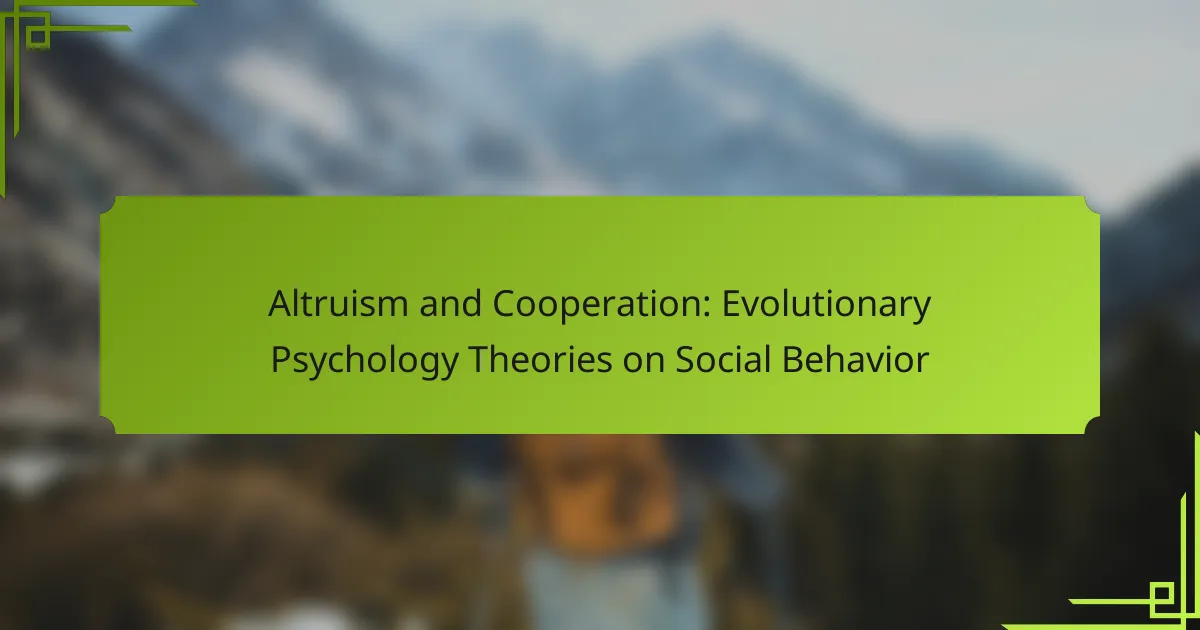Altruism significantly influences social behavior, enhancing cooperation and trust within communities. This article explores evolutionary psychology theories on altruism, its unique attributes, and how it fosters social cohesion. It examines the role of empathy, cultural influences, and the impact of altruistic actions on group dynamics. Understanding these concepts can improve relationships and promote collaborative problem-solving in society.
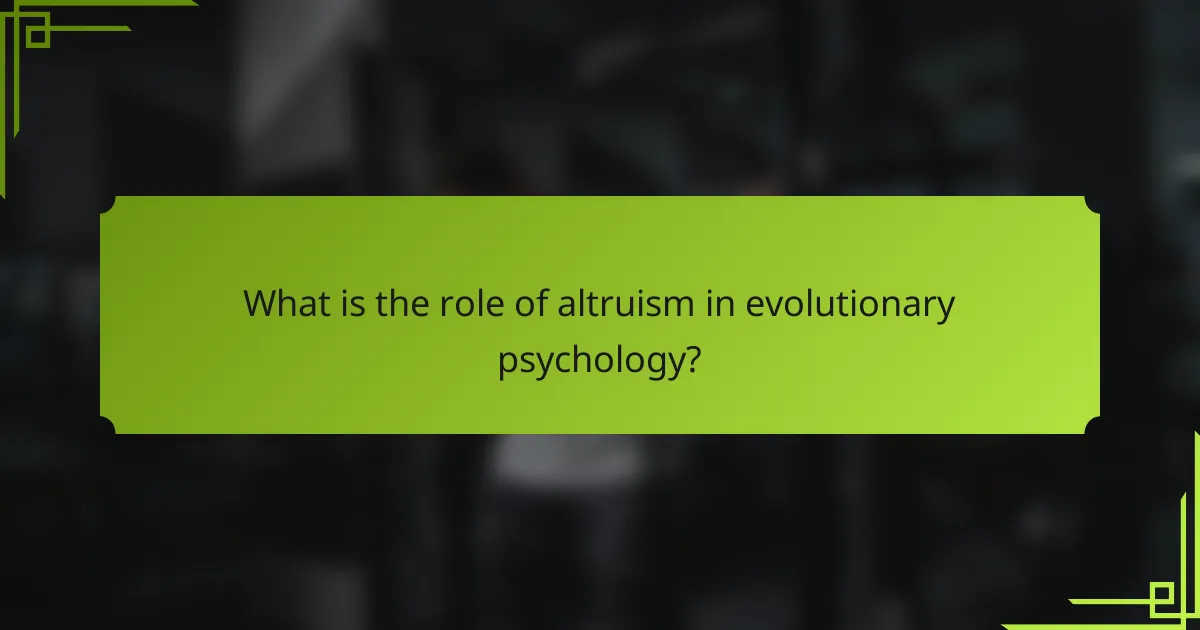
What is the role of altruism in evolutionary psychology?
Altruism plays a significant role in evolutionary psychology by enhancing cooperative behaviors that benefit social groups. It fosters trust and reciprocity, which are essential for group survival. Theories suggest that altruistic acts can improve an individual’s inclusive fitness, as helping others may lead to mutual support in challenging environments. Unique attributes of altruism include its capacity to strengthen social bonds and promote group cohesion, ultimately contributing to the evolutionary success of cooperative species.
How does cooperation influence social behavior?
Cooperation significantly enhances social behavior by fostering altruistic actions among individuals. Altruism, rooted in evolutionary psychology, promotes group cohesion, increasing survival rates. Studies indicate that cooperative societies tend to thrive, as individuals who engage in altruistic behavior strengthen social bonds and enhance mutual support. This dynamic encourages a culture of trust, vital for effective collaboration and community resilience.
What are the evolutionary advantages of altruistic behaviors?
Altruistic behaviors provide evolutionary advantages by enhancing group survival and fostering cooperation. These behaviors promote social bonds, leading to reciprocal altruism, where individuals help others with the expectation of future aid. This mutual support increases the likelihood of survival for all members of the group.
Moreover, altruism can improve reproductive success by ensuring that kin receive support, which is vital for passing on shared genes. In social species, such as humans, altruism often results in stronger community ties, enhancing overall resilience against environmental challenges. As a result, groups exhibiting altruistic behaviors tend to thrive, demonstrating that cooperation is beneficial for evolutionary fitness.
What mechanisms promote cooperation among individuals?
Cooperation among individuals is promoted by mechanisms such as reciprocal altruism and kin selection. These evolutionary psychology theories explain how social behaviors enhance survival and reproductive success. Reciprocal altruism encourages individuals to help others with the expectation of future help, fostering trust and collaboration. Kin selection emphasizes the importance of helping relatives, as it increases the likelihood of shared genetic material being passed on. Both mechanisms illustrate how cooperation can arise from self-interested actions that ultimately benefit the group.
How do cultural differences impact altruism and cooperation?
Cultural differences significantly influence altruism and cooperation by shaping social norms and expectations. For example, collectivist cultures often emphasize group harmony, leading to higher cooperation levels, while individualistic cultures may prioritize personal gain, affecting altruistic behaviors. Research indicates that these cultural frameworks create unique attributes in social behavior, such as varying definitions of reciprocity and community support. Understanding these differences can enhance cross-cultural interactions and promote effective collaboration.
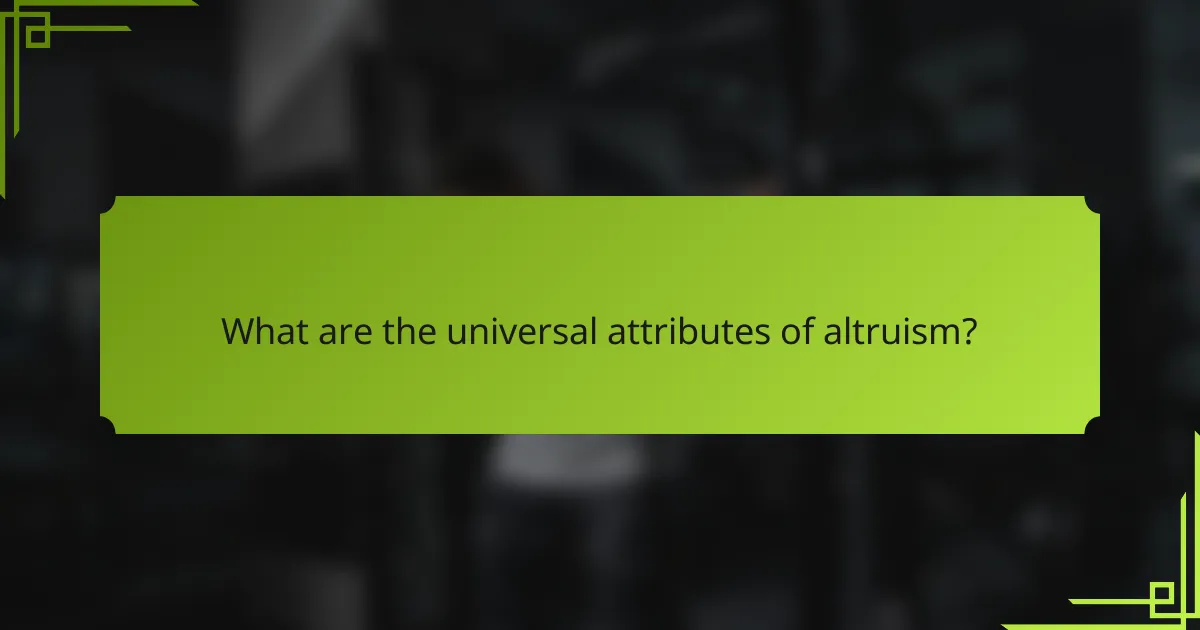
What are the universal attributes of altruism?
Altruism universally embodies selflessness, empathy, and cooperation. These attributes drive individuals to prioritize the welfare of others, often leading to prosocial behaviors. Empathy enables emotional connections, fostering support within communities. Cooperation enhances group dynamics, essential for survival and social cohesion.
How does empathy contribute to altruistic actions?
Empathy significantly drives altruistic actions by fostering a connection to others’ emotions. It enhances understanding and motivates individuals to help those in need. Empathetic individuals often experience emotional responses that lead to prosocial behaviors, reinforcing social bonds. Research indicates that empathy can activate brain regions associated with reward, making altruistic actions feel satisfying. This connection between empathy and altruism highlights the evolutionary importance of cooperation for societal survival and cohesion.
What are the common forms of altruism observed globally?
Altruism is commonly observed in forms such as charitable giving, volunteering, and prosocial behavior. These manifestations reflect a deep-rooted evolutionary trait that promotes cooperation among individuals.
Charitable giving often involves financial contributions to support various causes, enhancing community welfare. Volunteering entails dedicating time and effort to assist others, fostering social bonds. Prosocial behavior includes acts like sharing and helping, which can strengthen group cohesion.
Research indicates that these forms of altruism can vary by culture but share the underlying motive of enhancing collective well-being. In many societies, altruistic actions are linked to improved mental health and social connections, showcasing their unique benefits.
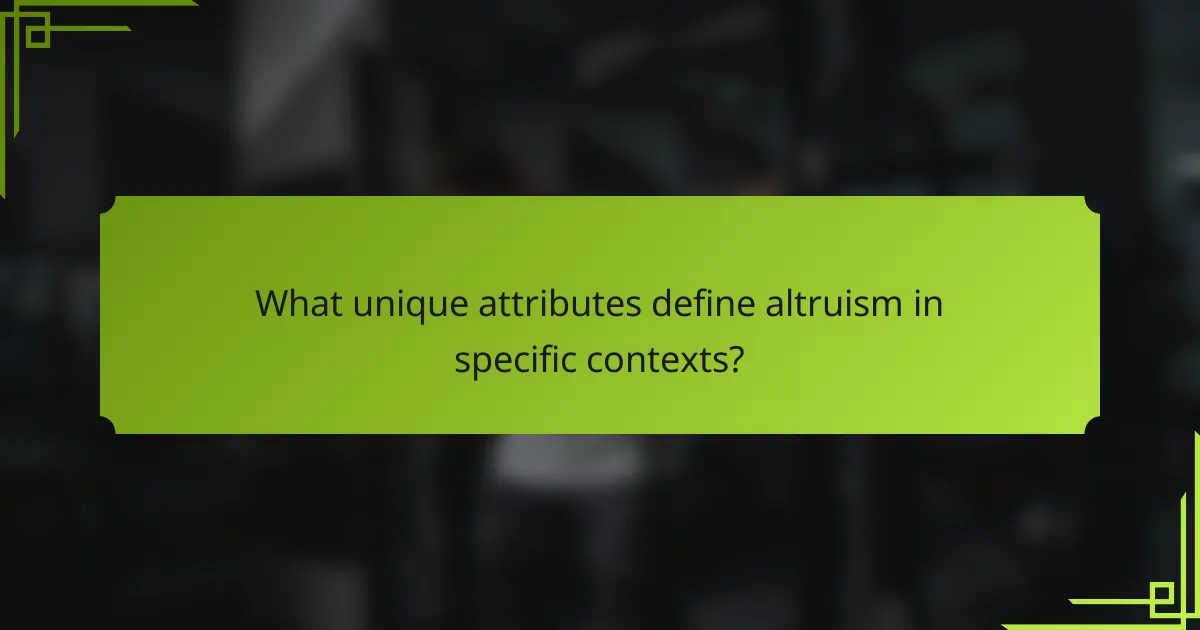
What unique attributes define altruism in specific contexts?
Altruism is defined by unique attributes such as context-specific motivations, cultural influences, and situational factors. These attributes shape altruistic behavior in various social environments. For instance, individuals may exhibit stronger altruism in close-knit communities compared to larger, more anonymous settings. Additionally, the presence of social norms can enhance cooperative behaviors, while evolutionary perspectives suggest that altruism may arise from kin selection or reciprocal altruism. These unique attributes demonstrate how altruism adapts to specific contexts, reflecting underlying psychological and social dynamics.
How does kin selection affect altruistic behavior?
Kin selection plays a crucial role in promoting altruistic behavior by favoring actions that benefit genetically related individuals. This evolutionary theory suggests that individuals are more likely to engage in selfless acts towards relatives, enhancing the survival of shared genes. For example, a parent may sacrifice personal gain to ensure the safety of their offspring, which ultimately aids in the continuation of their genetic lineage. This behavior reflects a unique attribute of kin selection, emphasizing the importance of genetic relatedness in social interactions.
What is the significance of reciprocal altruism in human societies?
Reciprocal altruism significantly enhances cooperation in human societies by fostering trust and long-term relationships. This behavior encourages individuals to help others with the expectation of receiving help in return, promoting social bonds. Studies show that reciprocal altruism can lead to increased survival rates and resource sharing within communities. Additionally, it serves as a foundation for moral norms and cultural practices that reinforce cooperation, highlighting its unique role in evolutionary psychology.
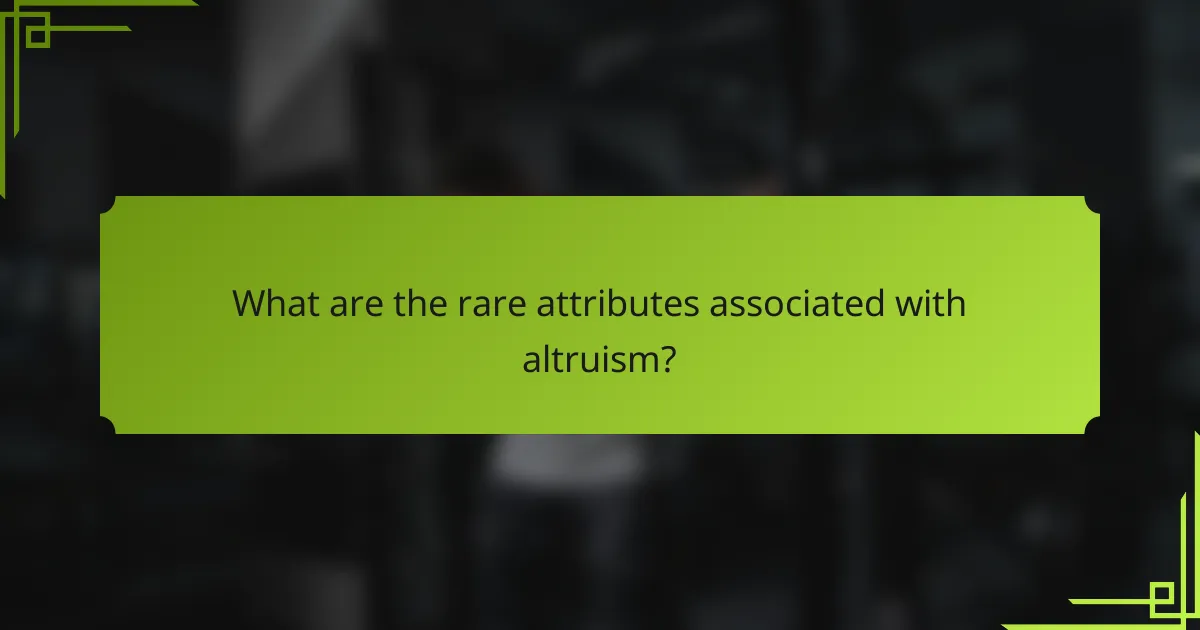
What are the rare attributes associated with altruism?
Rare attributes associated with altruism include self-sacrifice, empathy-driven actions, and spontaneous cooperation. These traits manifest uniquely in individuals, reflecting deep emotional connections and societal influences. Self-sacrifice often occurs in life-threatening situations, showcasing extreme forms of altruism rarely seen in everyday interactions. Empathy-driven actions arise from strong emotional responses to others’ suffering, motivating individuals to help in ways that are not always beneficial to themselves. Spontaneous cooperation highlights instances where individuals act for the collective good without prior planning, demonstrating a unique aspect of social behavior that reinforces community bonds.
How do extreme altruistic acts differ from everyday behaviors?
Extreme altruistic acts significantly differ from everyday behaviors in their intensity and impact. Extreme altruism often involves self-sacrifice or risking personal safety for the benefit of others, while everyday behaviors typically include smaller, more routine acts of kindness.
Extreme altruistic acts can result in profound social change, whereas everyday behaviors contribute to a more gradual, cumulative effect on community well-being. The motivation behind extreme acts may stem from unique attributes such as a strong moral conviction or a rare opportunity to help, contrasting with the common motivations for everyday kindness, which often arise from social norms or personal convenience.
Research in evolutionary psychology suggests that extreme altruism may have evolved as a mechanism for strengthening social bonds and ensuring group survival, highlighting its unique role in human cooperation.
What role does altruism play in crisis situations?
Altruism significantly enhances cooperation during crises. Individuals often prioritize collective well-being over personal interests, fostering unity and resilience. This behavior can lead to quicker recovery and improved outcomes in challenging situations. Research indicates that altruistic actions can strengthen social bonds, which are crucial for effective crisis management.
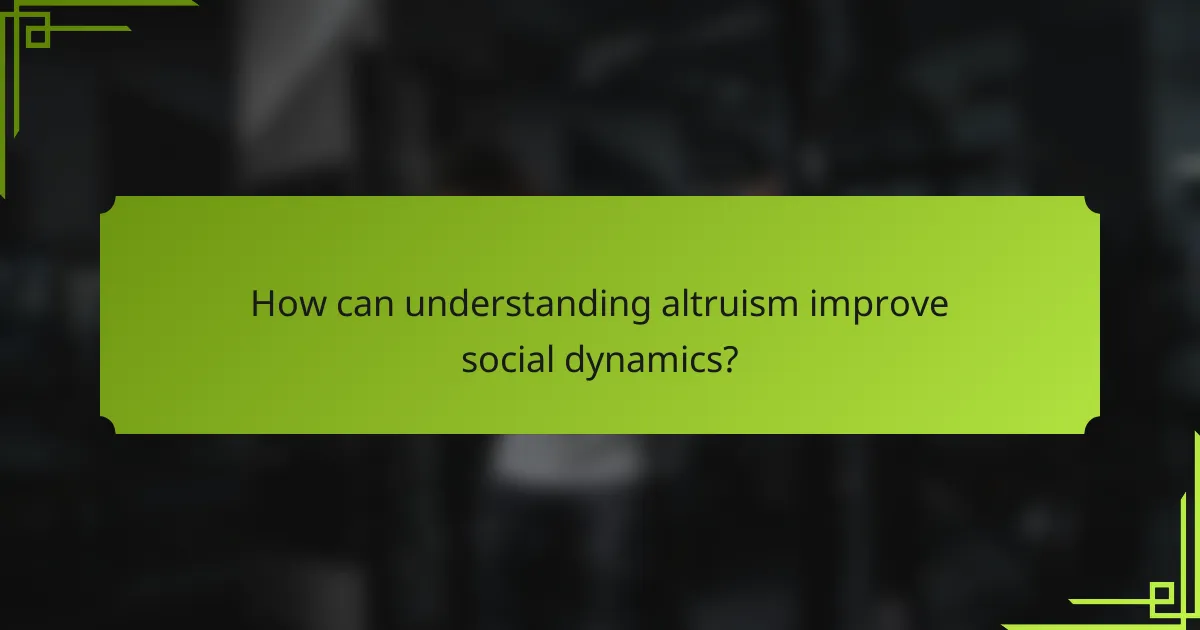
How can understanding altruism improve social dynamics?
Understanding altruism enhances social dynamics by fostering cooperation, trust, and community bonds. Altruistic behaviors can lead to stronger relationships and increased social cohesion, as individuals prioritize collective well-being over self-interest. This shift encourages collaborative problem-solving, which is vital in addressing societal challenges. Moreover, altruism can create positive feedback loops; as people engage in selfless acts, it inspires others to do the same, amplifying the effects on social networks. Ultimately, recognizing the role of altruism in social behavior can lead to more harmonious and productive communities.
What best practices can enhance cooperative behavior in communities?
Fostering cooperative behavior in communities involves promoting altruism through shared goals and social norms. Encouraging open communication strengthens relationships, while recognition of contributions enhances motivation. Implementing community projects can create a sense of belonging, further reinforcing cooperative actions. Engaging in collective problem-solving fosters trust and collaboration, essential for lasting cooperation.
How can individuals avoid common mistakes in altruistic efforts?
Individuals can avoid common mistakes in altruistic efforts by focusing on clear goals and understanding the needs of those they aim to help. Prioritize effective communication to ensure the intended impact. Assess the motivations behind actions to prevent self-serving behaviors that can undermine altruism. Engage with the community to gain insights and foster genuine connections, enhancing the overall effectiveness of altruistic initiatives.
What expert insights can guide effective altruism in modern society?
Effective altruism in modern society can be guided by insights from evolutionary psychology that emphasize cooperation. Understanding the innate human tendencies towards altruism helps in promoting collaborative social behaviors. Research shows that cooperative behaviors enhance group survival, indicating a biological basis for altruism. This perspective encourages initiatives that leverage social norms and shared goals to foster altruistic actions. By aligning personal values with community benefits, individuals can contribute to a more altruistic society.
